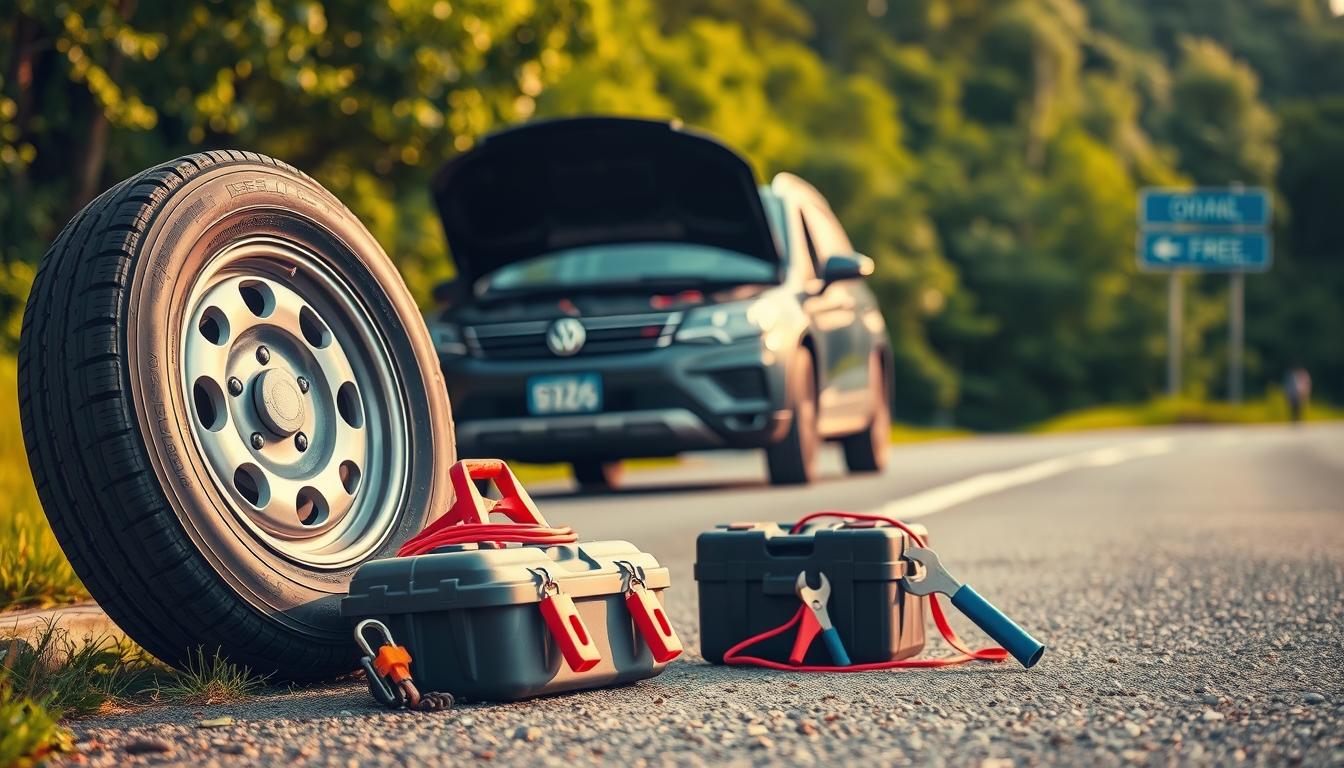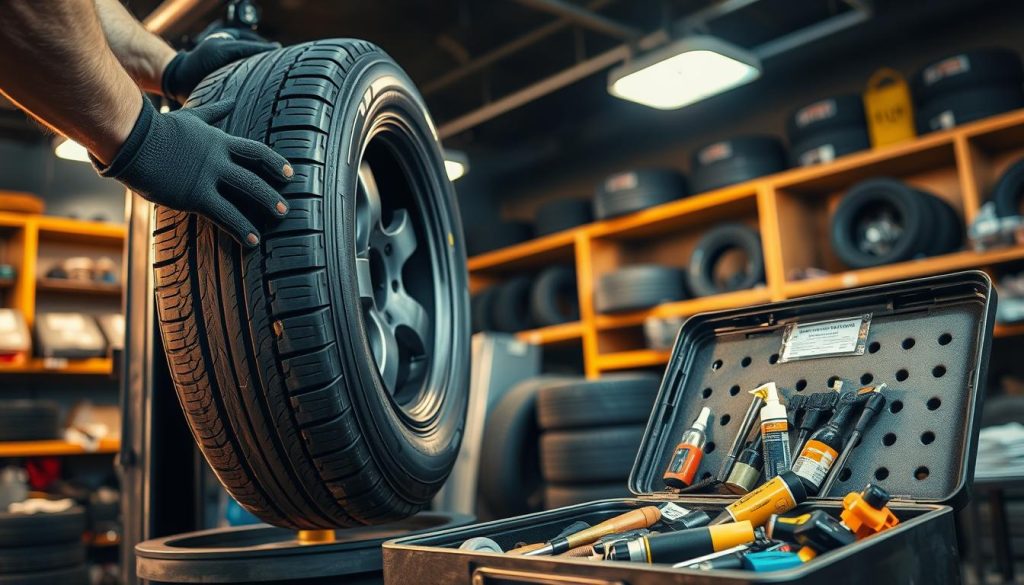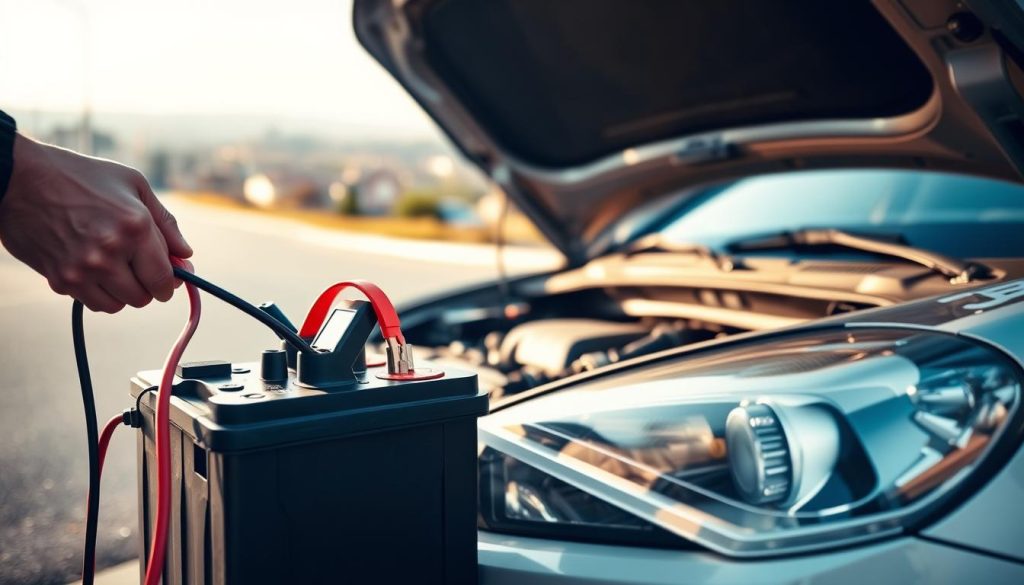
Picture this: You’re driving home on a side road when suddenly your car sputters. Your heart races as you pull over. Sound familiar? With 220 million flat tires happening yearly in the U.S. alone, breakdowns don’t discriminate – they strike new cars, old trucks, and every driver in between.
But here’s the good news: Most roadside issues follow predictable patterns. From dead batteries to lockouts, these situations become manageable when you know the playbook. Did you know 95% of drivers panic during their first breakdown? Yet with simple preparation, you could be part of the calm 5%.
This guide transforms scary what-ifs into solvable puzzles. We’ll show you how to handle roadside emergencies like a pro. Why waste hours stranded when quick fixes exist? Your next road trip doesn’t have to become a horror story – let’s make sure you’re ready for any vehicle issues, whether it’s a brake problem or a transmission failure.
Ever wonder why some drivers stay calm when their vehicle stops working? Breakdowns don’t care if you’re driving a shiny SUV or a trusted sedan. They strike when you least expect – during rush hour, on empty country roads, or while picking up kids from soccer practice.
Modern vehicles might have fancy tech, but they’re not invincible. A study found 1 in 5 breakdowns involve cars less than three years old. Why? Complex electronics hate temperature swings. Summer heat fries sensors, while winter cold thickens fluids.
Check your tires monthly like you check phone notifications. That weird engine noise? It’s your car crying for help. Simple actions prevent most roadside headaches and can save you from needing assistance from a provider:
| Breakdown Cause | Prevention Tips | Time Needed |
|---|---|---|
| Dead Battery | Clean terminals every 6 months | 15 minutes |
| Overheating | Check coolant monthly | 5 minutes |
| Fuel Issues | Refill at ¼ tank | None |
| Tire Damage | Rotate tires annually | 30 minutes |
Gas prices might tempt you to push that fuel light, but running dry strains your fuel pump. Make sure your emergency kit includes jumper cables and a flashlight. Remember: Good drivers don’t just react – they prepare for any situation, whether on the side road or elsewhere.
What would you do if your steering suddenly pulled to one side? That sudden thump-thump-thump means trouble. Every driver faces tire issues eventually – even with modern rubber technology. But here’s the secret: smart preparation turns panic into confidence.

First – breathe. Find level ground away from traffic. Activate those flashing lights immediately. Your car manual holds the map to your spare and tools location. Follow this sequence:
Remember: Donut tires have speed limits. Need professional flat tire repair? Mobile services exist for permanent fixes.
Stop problems before they strand you. Your tires whisper warnings through wear patterns and pressure changes. Try this simple routine:
| Maintenance Task | Frequency | Tools Needed | Benefit |
|---|---|---|---|
| Pressure Check | Monthly | Gauge | Prevents blowouts |
| Tread Depth Test | Seasonally | Quarter | Improves traction |
| Rotation | Every 5,000 miles | Jack stand | Even wear |
| Spare Inspection | Every oil change | Hand pump | Ready backup |
See cracks in the sidewall? That’s replacement time. Notice uneven wear? Get an alignment. Simple checks add years to your tires’ life – and keep you rolling safely. Regular car maintenance can help prevent many common roadside problems before they occur.
What’s worse than turning your key and hearing silence? Vehicle power failures strike when you least expect them. Whether it’s a drained battery or an empty tank, these emergencies test every driver’s preparedness. Let’s turn panic into action with practical solutions.

That clicking sound means your battery needs help. Grab those jumper cables and find a helper. Remember: red clips connect to positive terminals first. Black goes to the donor car’s negative post, then your engine block. This order prevents dangerous sparks.
| Battery Issue | Quick Fix | Prevention Tip |
|---|---|---|
| Complete Drain | Jump-start | Test every 6 months |
| Corroded Terminals | Baking soda scrub | Clean quarterly |
| Old Battery | Replacement | 3-5 year lifespan |
Your gas gauge hits E? Stay calm. Coast to the shoulder and turn on hazards. Use your phone to find the nearest gas station – most mapping apps show fuel stops. Never walk on highways; call for help instead.
Smart drivers refill at ¼ tank. Long trips? Plan stops every 150 miles. Keep an emergency gas can if you often push limits. Remember: Running dry damages fuel pumps over time.
Ever left your keys dangling in the ignition while the door slams shut? We’ve all done it – that heart-sinking moment when metal meets lock. But what about steaming hoods or flickering dash lights? These three challenges test every driver’s cool.
Create a key routine like brushing teeth. Tap your pocket before shutting doors. Keep a spare in a wallet, not under the bumper. Modern key fobs? Replace batteries yearly. Try this table for lockout prevention:
| Mistake | Solution | Tool |
|---|---|---|
| Forgetting keys | Phone reminder | App alert |
| Broken fob | Manual key extraction | Screwdriver |
| Lost keys | Code-copy service | Dealer contact |
Smoke billowing? Don’t pop the hood yet. Pull over and turn off the engine. Wait 30 minutes – hot coolant burns. Check levels only when safe. Low fluid? Add 50/50 water-coolant mix slowly.
Flickering lights often mean loose battery cables. Tighten connections with a wrench. Test your alternator by turning on headlights – if they dim at idle, get it inspected. Blown fuses? Match amp numbers exactly when replacing.
Remember: Electrical gremlins worsen if ignored. When dashboard warnings flash, act fast. Simple fixes today prevent tow trucks tomorrow.
Your car speaks – are you listening? That faint squeal when braking or the flickering oil light aren’t random. They’re urgent messages saying “Help me before it’s too late.” Smart drivers treat these signals like text alerts – respond quickly, avoid bigger issues.
Dashboard lights form their own language. Red means stop now, yellow suggests schedule service soon. Heard grinding noises? Your brakes might be begging for attention. Smell burnt toast? That’s often overheating electrical components.
| Symptom | Possible Issue | Immediate Action |
|---|---|---|
| Steering vibration | Unbalanced tires | Reduce speed |
| Fluid puddles | Leaking oil/coolant | Check levels |
| High-pitched squeak | Worn brake pads | Visit repair shop |
Not all help services are equal. Ask providers these key questions:
Top-rated plans connect you directly to vetted mechanics – not just whoever’s nearby. Remember: Cheap roadside assistance packages often mean longer waits and questionable service quality. Your safety’s worth the extra $5/month.
Ready to turn breakdowns into mere speed bumps? You’ve now got the tools to handle most vehicle hiccups. Remember that weird noise last Tuesday? That was your car asking for attention before trouble strikes.
Smart drivers treat their vehicles like teammates. Check oil levels with coffee refills. Test brake lights while waiting at stop signs. These tiny habits prevent 80% of roadside headaches.
When things go south, stay cool. Your emergency kit and phone can solve most issues. For bigger problems – smoking transmissions or dead alternators – call trusted towing services. They’ve got the gear your trunk can’t hold.
Here’s the golden rule: Maintenance beats repairs. Schedule service checks like dentist appointments. Keep your roadside assistance number handy, just like your favorite pizza place.
Your next adventure awaits. Pack knowledge instead of fear. With these tips, you’ll spend less time stranded and more time making memories. After all, isn’t that why we hit the road?
Check tire pressure monthly and before long trips. Use a reliable gauge and refer to your vehicle’s manual for ideal PSI. Underinflated tires wear faster and reduce fuel efficiency.
You’ll need another vehicle with a working battery and jumper cables. Connect red to red (+), black to unpainted metal. Start the working car first, then yours. Always follow safety steps to avoid sparks.
Keep a spare key in a magnetic box under your car or with a trusted contact. For immediate help, call a locksmith or roadside assistance like AAA. Never try to pry doors open—it risks damage.
Low coolant, a broken thermostat, or a faulty radiator fan are common causes. Pull over safely, turn off the engine, and let it cool before checking coolant levels. Avoid opening the hot radiator cap!
Look for 24/7 availability, clear pricing, and reviews. Providers like Good Sam or Allstate Motor Club offer towing, fuel delivery, and lockout help. Ask about response times and coverage areas before signing up.
Pack jumper cables, a spare tire, jack, flashlight, and basic tools. Add coolant, brake fluid, and a portable phone charger. A first-aid kit and blanket are smart for unexpected delays.
Red lights like “Check Engine” or “Oil Pressure” mean stop driving ASAP. Yellow lights signal caution—get to a shop soon. Ignoring them could lead to costly repairs or breakdowns.
Request Emergency Roadside Assistance
Use the form here and we’ll respond as quickly as possible or call the number displayed.